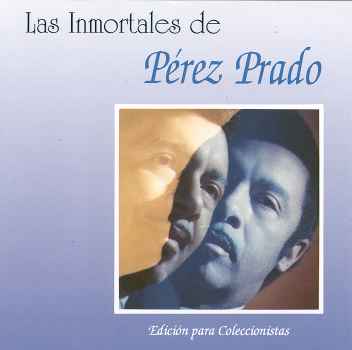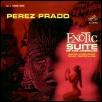Pérez Prado and Mambomania
Part 4

Working With El Rey
In the studio and on the bandstand, Prado developed a reputation as a perfectionist and a task-master. Trombonist Milt Bernhart recalled an incident during the recording of Voodoo Suite, a collaboration with arranger Shorty Rogers:
"One of the movements involved a supposed street fight in Havana - Carlos Vidal (conga drums) and another Cuban percussionist were to play the roles of the two participants in the rumble. After running the music down once or twice, one of them decided to really get into the spirit of the thing - he stripped down to his shorts!
"Now, we began to record it. In the middle of their chanting and howling, they forgot where they were and really started to grapple. They were mad and they were wrestling. Half the band fell completely apart. The 'take' stopped cold and I fell on the floor convulsed. Prado seemed to be offended by our laughter and was glaring at me - and possibly Maynard Ferguson - we were in hysterics! The trombone player next to me, who was a regular Prado member, sat staring straight ahead, he didn't get it or he was afraid of Prado's anger.
"I learned later that Prado fired him - he hadn't done anything."
Drummer Ed Shaughnessy once talked about the New York recording sessions for albums on which he played, including Havana 3 a.m. and Voodoo Suite. Most of the musicians, like himself, were session men. Because of union regulations, only the percussionists were from the regular Prado Orchestra (this was also true of his touring bands in the US). Prado did not speak English and was often forced to use an interpreter. At other times he just pointed to the score and demanded (in Spanish) that the mainly Anglo musicians play what was written. He remembered that Prado used a lot of sign language "with every part of his body."
Later Years
As early as 1954, Prado realized that no fad lasts forever and introduced two new dances, the suby and the pau-pau. The former was an accelerated version of the mambo and the latter, a slower one. Neither caught the public's fancy. In 1955, he tried again, also without success, to counter the Cha-cha-cha with La Culeta. The cha-cha had been introduced the previous year by Cuban violinist Enrique Jorrin. La Culeta was a milder mambo-like dance which was actually a predecessor of the cha-cha, itself. Ironically, in 1956 he appeared in the Columbia Pictures film Cha-Cha-Cha Boom, which was attempt to cash in on the new craze and featured Prado, Luis Alcarez, Helen Grayco (then married to Spike Jones), and the Mary Kaye Trio.
In 1958, he had his final hit with "Patricia" (on the US charts for 21 weeks, including one week at #1), which was also used by Nino Rota as the theme song for Federico Fellini's 1960 movie La Dolce Vita. RCA continued to support him through the early 1960s, but the recordings became increasingly steeped in gimmicks like mambo versions of the twist and rock-n-roll numbers. Finally, there were La Chunga and El Dengue, the dance crazes that never really happened. Unfortunately, Prado's later work never had the spontaneous excitement so evident in the Mexico City recordings of 1949-1950. With the end of the 1950s, his success declined and the years gave way to new rhythms, like the pachanga and then the boogaloo. Prado's recorded output was mainly limited to smaller labels and recycled Latin-style anthologies.
In the early 1970s, Prado permanently returned to his apartment off Mexico City's grand Paseo de la Reforma to live with his wife and two children, son Dámaso Pérez Salinas (also known as Pérez Prado, Jr.) and daughter Maria Engracia. Despite his fading star in the US, his career in Latin America was stronger than ever. He still toured and continued to record material which was released in Mexico, South America, and Japan. There he was revered as one of the reigning giants of the music industry and was a regular performer on Mexican television. In Japan, a live concert recording of his 1973 tour was released on LP in an early 4-channel format.
In 1981, he was featured in a musical revue entitled Sun which enjoyed a long run in the Mexican capital. His last American appearance was at the Hollywood Palladium on September 12, 1987, when he played to a packed house. This was also the year of his last recording. Persistent ill health plagued him for the next two years and he died of a stroke in Mexico City on September 14, 1989, at the age of 72.
During his lifetime, a cast of musical luminaries passed through his orchestra These included Cuban singer Beny Moré, trumpeter Pete Candoli, bongo and conga drummer Armando Parazo, percussionists Johnny Pacheco and Mongo Santamaria, and reedman (later bandleader) Rene Bloch. A decade after his death, the popularity of Prado's music was on the rise again. The exciting "Guaglione" almost made it to the top of the charts in the UK following its use in a Guiness Ale television commercial and his entire catalogue of recordings is available today on compact disc. The mambo, reinvigorated under the name salsa, is still the signature dance of Latin popular music and Pérez Prado, Jr., continues to direct the Pérez Prado Orchestra in Mexico City, today.

Pérez Prado
Discography
Joseph Levy lives in New York State (in the USA) and is an artist, record collector, and author of The Vinyl Tourist web site.
Sources:
- Barbara Squier Adler, "The Mambo and the Mood," The New York Times Magazine, September 20, 1951, pp. 20, 22
- Donald Clarke, ed., The Penguin Encyclopedia of Popular Music, Viking London, 1989, pp. 758, 929-930
- Dance Magazine:
- Albert and Josephine Butler, "Mambo - Today," December, 1953, pp. 52-53
- Robert Luis, "Rumba's Anniversary," June 1958, pp. 66-67
- Dorothea Duryea Ohl, "Mambo Not A Dance?," June, 1958, pp. 67-68
- Robert Farris Thompson, Jr., "Mambo With Pantomime," June 1958, pp. 68-69
- Robert Luis, "Mambo Debate (Cont'd)," August, 1958, pp. 64-65
- Robert Farris Thompson, Jr., "Palladium Mambo - II," November, 1959, pp. 70-71
- Down Beat:
- "Prado Denied Job With Band Here; Needs AFM Card," May 18, 1951, p.1
- "Prado One-Niter Sets L.A. On Ear," September 21, 1951, p. 1
- Ralph J. Gleason, "Prado's West Coast Tour Proving A Huge Success," October 5, 1951, p. 15
- "Prado, Bandsmen Injured In Bus Crash...," November 30, 1951, p. 1
- Don Freeman, "Prado Has Touch That Sets Fire To Band, Says Sideman," December 28, 1951, p. 19
- Ralph J. Gleason, "Latin Leaders Explain Origin Of The Mambo," January 25, 1952, p. 2
- Perez Prado (translated by Jack Preston), "Perez Prado--I'm Ready To Touch Off Revolution," April 21, 1954, p. 29
- "Perez Slaps $500,00 Suit On Pantaleone," May 30, 1956, p. 7
- Peter Grendysa, liner notes to Mambo Mania (Bear Family BCD 15462), 1993
- Mark Holston, "King of the Mambo," Américas, Volume 37, No. 5 (Sept-Oct, 1985), pp. 56-57
- Colin Larkin, ed., The Guiness Encyclopedia of Popular Music, Guiness Publishing, 2nd edition, 1995, pp. 3308-3309
- Isabelle Leymarie, "Salsa and Latin Jazz," (Chapter 6) in Hot Sauces ~ Latin Jazz and Caribbean Pop, Billy Bergman, ed., , Quill, New York, 1985, pp. 96-102
- Richard Lamparski, Whatever became of..., Eleventh Series, Crown, New York, 1989, pp. 148-149
- Peter Manuel, Popular Music of the Non-Western World, Oxford University Press, New York & Oxford, 1988, pp. 26-36
- Jeremy Marre and Hannah Charlton, Beats of the Heart - Popular Music of the World, Pantheon, New York, 1985, pp. 70-72
- Michael Mcdonald-Ross, Dámaso PÉREZ PRADO, Musical biography, unpublished, 1992.
- Newsweek:
- "El Mambo," September 4, 1950, p. 76
- "Mambomania," Newsweek, August 15, 1954, p. 54
- Bill Simon, "Mambo For All," Saturday Review, September 25, 1954, p. 63
- Robert Farris Thompson, Jr., Jazz Review, September-October, 1950
- Time:
- "The Mambo," August 9, 1951, pp. 38, 41
- "Mambo-San," July 25, 1955, p. 66.
- Barry Ulanov, Metronome, December, 1950
- Marta Moreno Vega, "The Yoruba Tradition Comes To New York City," African American Revue, Volume 21, Issue 2 (Summer, 1995), p. 201
- Walter Waldman, "Mambo: The Afro-Cuban Dance Craze," American Mercury, January, 1952, pp. 14-20
- Jerry Wexler, liner notes to Pérez Prado Plays Mucho Mambo! (RCA EPA-302), 1951
- Watson Wylie, liner notes to Dilo (ugh!) (RCA LPM/LSP-1883), 1958
Additional Reading:
- Mambo Mania: A Brief History of the Mambo by Isabelle Leymarie
- Salsa & Mambo FAQ by Enio Cordoba
There is also a newsgroup where Prado is sometimes mentioned:
Another related site:
- Los Reyes del Mambo - The Mambo Kings (Los Reyes del Mambo) is a Mexican orchestra that plays original Prado compositions and includes many original members of the Prado band.
 |
 |
 |
 |
Main Page |
Site Map & Links |
This Record? |
|---|